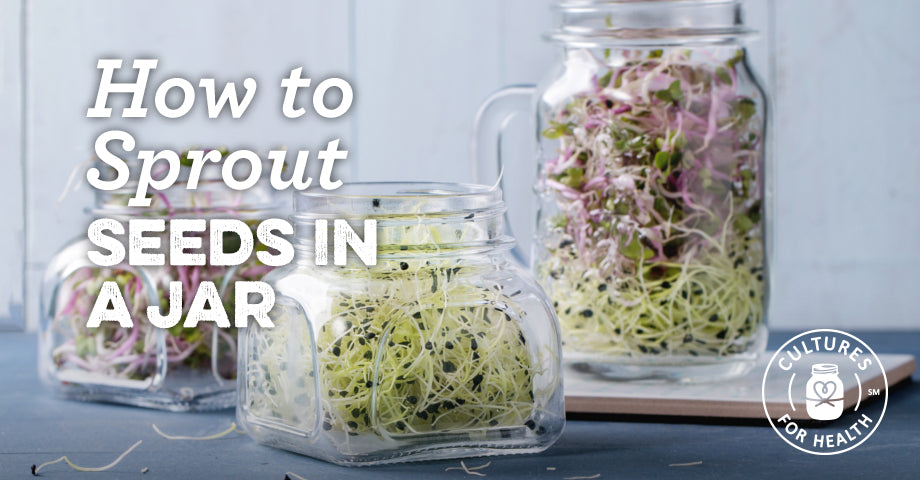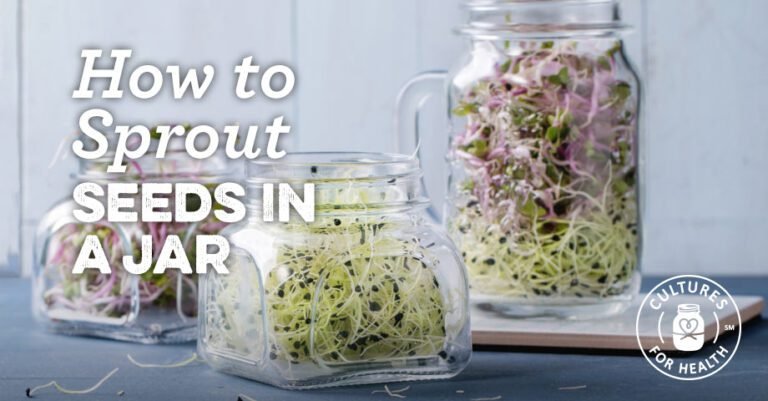
Would you like to go on a journey to grow? We will be happy to assist you. From seed to sprout, Cultures for Health guides you through every step of the process.
The most popular and convenient way to germinate seeds at home is using jars. A great way to grow fresh organic vegetables at home. It’s also a great way to save money and avoid chemicals used in store-bought produce. Additionally, anyone can easily germinate seeds in a jar. All you need are seeds, water, and a jar that you can cover with cheesecloth.
Budding:
Before we get into how to grow sprouts at home, let’s lay the groundwork by explaining what seed germination is, the benefits of growing sprouts, and what you need to get started.
Understanding germination: from seed to sprout
Seed germination, or simply “sprouting”, is the process of turning a dormant seed into a vibrant, living bud. This journey from seed to bud is one of nature’s miracles that we can easily recreate at home.
Germination can be done with most types of seeds, including grains such as peas, beans, lentils, and even rice. Sprouts can be grown at home and are easy to grow even in small spaces. Not only is it easy, the bean sprouts can be used in a variety of dishes.
Additionally, home-grown sprouts are often much cheaper than store-bought sprouts. You should start making new sprouts every week or two to meet your family’s appetite.
Starting from seeds or sprouts also minimizes the environmental impact of food waste.
How to germinate seeds: why it’s good for you
Sprouting is a great way to get the most out of your favorite seeds and legumes. Sprouting activates enzymes and increases the nutritional content of foods, making them more digestible, nutritious, and tastier. Other benefits of sprouting include:
Growing sprouts in a jar: a step-by-step guide
One of the easiest and most common ways to germinate seeds is in a jar. This doesn’t require much equipment and you can start the seed germination process at home by following these simple steps.
1. Selection of jars and lids for germinating seeds:
When choosing a jar, consider the size of the sprouts you plan to grow. A jar with a wide opening is usually most convenient for rinsing, draining, and removing germinated seeds.
2. Rinse seeds before germination:
Wash the seeds thoroughly in cold water (about 70°F) and drain. Remove any debris, stones, or broken seeds. When germinating small seeds, removing broken seeds is not practical. However, if possible, look for non-seed material and remove it at this point.
Note: Do not use cold or boiling water as this can damage the seeds.
3. Soak and germinate seeds:
Place the washed seeds in a jar and fill it about 3/4 full with cold water. cover withmesh lid Or secure the fabric with a rubber band to ensure airflow.
The general rule is to soak for at least 8 hours. Some larger seeds may require longer soaking times. Soak the seeds until they double in size. Note that temperature also affects soaking time. If the temperature is high, the soaking time will be shorter. Colder temperatures will require longer soaking times, and larger seeds such as chickpeas and kidney beans may need to be soaked for 24 hours.
4. Drain germinated seeds:
Once the seeds are soaked and the journey from seed to germination begins, it is important to drain them well. A well-drained environment is essential for the healthy growth of new shoots.
5. Rinse, drain and repeat the process to germinate seeds:
Rinse the sprouts with cold water and repeat the draining process, nurturing the seeds as they turn into sprouts. Usually 2-3 days of rinsing and draining three times a day is sufficient.
If the temperature is very high, rinse more often. In colder climates, rinsing less often is fine, but be aware that seeds may be less likely to germinate. Temperatures around 65 to 80 degrees Fahrenheit are fine for most seeds.
6. Final rinsing and draining to germinate seeds:
Once the seeds have fully germinated, give them a final rinse and drain. This will ensure that they are ready to eat or store, allowing you to get the most out of your sprouting operation.
Utilize germinated seeds
After going through the process from seed to sprout, the sprouts can be enjoyed in a variety of ways.
The sprouts can be eaten whenever the sprout tails appear. Taste the germinated seeds every day and enjoy if you find them delicious. Many seeds lose their mild flavor if germinated too long. Generally:
Germinate grains until sprout tails appear for cooking or dehydrationand grind into powder
Germinate the grains in a jar until a sprout tail appears, then transfer to a container.Soil for growing grass for juice.
Germinate legumes until the shoot tails appear or before the leaves appear.
Germinate the seeds to the desired length, tasting them daily.
Germinate the seeds in a jar until a bud tail appears, then transfer to a tray to grow longer buds. Alternatively, transfer the seeds to a tray filled with microgreen soil.
Storage of sprouts and germinated seeds
Sprouts are easy to grow in small batches and staggered, so you can have fresh sprouts every day. However, if you need to store it, make sure the sprouts are completely drained before storing. Transfer to a glass or plastic container, seal tightly and store in the refrigerator for several days.
Germinating with a culture for health
Now that you know exactly how to germinate seeds in a jar, it’s time to try it yourself. Cultures for Health can help.
From tools to starters to all-in-one kits, we have the best selection of all things fermenting. Cultures for Health is your one-stop shop for all your needs.
We offer three types of seeds that can be used for germination, depending on the type of bud you desire.
At Cultures for Health, we aim to make the process of growing sprouts in a jar easy and rewarding. We provide all the essentials you need to germinate your seeds and help you enjoy the fruits of your germination efforts.
Frequently asked questions about how to grow sprouts in a jar:
If you’re just starting your germination journey, you probably have a few questions. Below you will find answers to some of the most common questions about how to germinate seeds.
How long does it take for sprouts to grow in a jar?
It depends on the sprouts! Some sprouts, such as alfalfa, chickpeas, and green peas, may take as little as three days to grow. Some, like beets and sunflower seeds, are slow-growing (they may take 2-3 weeks to germinate).
Seed quality, in turn, affects the speed of seed germination. If the seeds are old or improperly stored, they will take longer to germinate. The best way to find out how long it will take to germinate is to check the packaging or online resources for that particular type of seed.
What kind of sprouts can you grow in a jar?
You can grow almost any type of sprout in a jar. Bean sprouts and pea sprouts, sprouted grains, vegetables, nuts, and other seed sprouts are all popular choices as well. Below are some suggestions.
alfalfa sprouts
broccoli sprouts
mung bean sprouts
beet buds
chickpea sprouts
red clover sprouts
mustard sprout
green pea sprouts
kale sprouts
lentil sprouts
radish sprout
sunflower sprouts
How many seeds does it take to germinate in a jar?
It depends on the type of seed, the type of sprouts you’re growing, and how long you plan on storing the jar. However, it’s generally a good idea to start with 2 tablespoons of seeds per quart-sized jar. This way your jar will be full of sprouts and you can enjoy them for days.
Do I need special seeds to germinate in a jar?
For beginners, we recommend using seeds sold specifically for germination. Sprouted seeds are specially manufactured to be free of certain chemicals that can be harmful to our health. Therefore, only buy seeds for germination. We can help provide some of that.The best germination supplies and seeds for home use.
Do sprouts need sunlight?
Although sprouts do not need sunlight to grow, they do need some light to photosynthesize and produce their own food. Be careful not to place the germination jar in direct sunlight. This can cause the sprouts to become too hot. Indoor light is sufficient for most growing stages.
Which seeds germinate fastest in a jar?
Lentils and mung beans are the fastest growing, sprouting in just three days. Alfalfa, chickpeas, and red beans take a little longer to grow and germinate in 3 to 5 days.
How to eat sprouts?
If you prefer, you can eat sprouts straight from the bottle, add them to salads, or grow them in the soil to add microgreens to your sandwiches. There are lots of great recipe ideas if you want to try them out or use up some extra sprouts.
raw sprouted granola
sprouted bean burger
sprouted lentil salad
Stir-fried bean sprouts
sprouted black bean soup
mint sprouted pea dip
Key points for growing sprouts at home:
Growing vegetables and herbs from seeds can be fun and rewarding. And it’s even happier to eat food you’ve made yourself throughout the season. Sprouts are a great way to start your gardening journey.
Sprouts are also a delicious and nutritious way to add volume and flavor to your meals. The process of seeding and germinating can be exciting and rewarding. With a little effort and the right knowledge, you can enjoy fresh homemade bean sprouts straight from your kitchen.
When you’re ready to start sowing your own seeds,Click here to check out our entire collection of sprouting products today!


